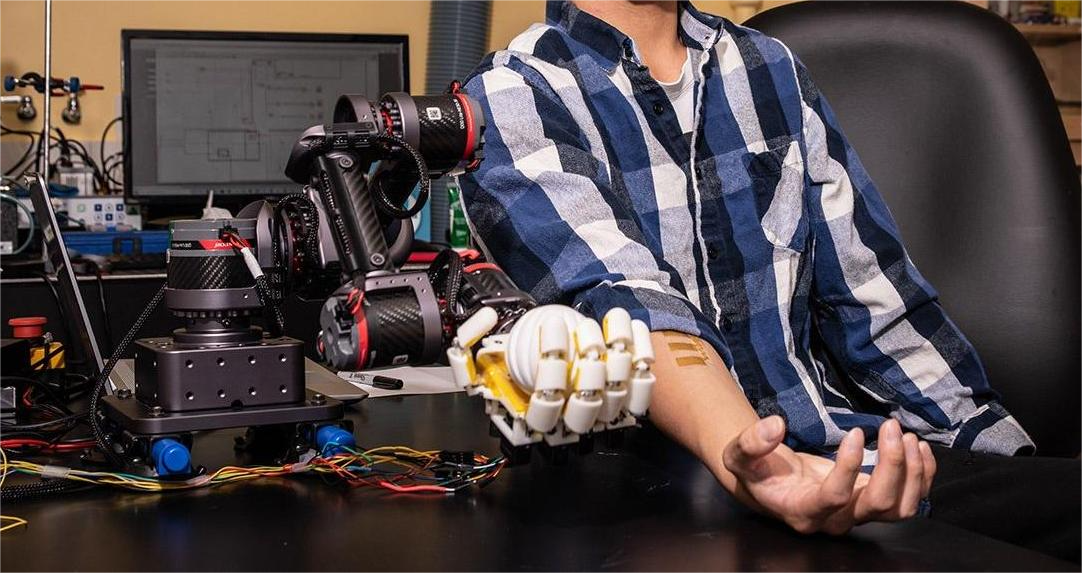创新背景
在日常环境中,人们对触觉习以为常,但这对于人们与周围环境互动的能力至关重要。想象伸手到冰箱里拿一个鸡蛋作为早餐。当手指触摸它的壳时,可以分辨出鸡蛋是冷的,它的壳是光滑的,以及需要多牢固地抓住它以避免压碎它。这些都是机器人,即使是那些直接由人类控制的机器人,也难以做到的能力。
创新过程
加州理工学院开发的一种新型人造皮肤现在可以让机器人通过简单的触摸来感知温度,压力甚至有毒化学物质。
这种新的皮肤技术是机器人平台的一部分,该平台将人造皮肤与机器人手臂和附着在人体皮肤上的传感器集成在一起。将两者连接起来的机器学习系统允许人类用户用自己的动作控制机器人,同时通过自己的皮肤接收反馈。
皮肤
人类手和机器人手的并排比较揭示了明显的差异。人类的手指柔软,粘稠和肉质,而机器人手指往往是坚硬的,金属的,可塑的或橡胶的。研究人员开发的可打印皮肤是一种凝胶状水凝胶,使机器人的指尖更像人类的指尖。
嵌入在水凝胶中的传感器使人造皮肤能够检测周围的世界。这些传感器按字面意思打印到皮肤上,就像喷墨打印机将文本应用于一张纸一样。
![]()
在打印了银纳米颗粒线的脚手架后,研究人员可以打印出微米级传感器层,这些传感器可以设计用于检测各种事物。传感器是打印出来的,这使得实验室可以更快、更轻松地设计和尝试新型传感器。
研究人员想要检测一种给定的化合物时,会确保传感器对该化合物具有高电化学响应。用铂浸渍的石墨烯可以非常快速和有选择地检测爆炸性TNT。对于病毒,他们正在打印具有非常高表面积的碳纳米管,并将病毒抗体附着在它们上面。这都是大规模可生产和可扩展的。
交互式系统
研究人员将这种皮肤与一个交互式系统相结合,该系统允许人类用户通过自己的肌肉运动来控制机器人,同时从机器人的皮肤接收到用户自身皮肤的反馈。
该系统的这一部分利用了额外的打印部件,在这种情况下,电极固定在操作员的前臂上。电极类似于用于测量脑电波的电极,但它们的位置是感知操作员的肌肉在移动手和手腕时产生的电信号。人类手腕的简单轻拂就会告诉机械臂向上或向下移动,而人类手指的紧握或摆动会促使机械手做出类似的动作。

研究人员使用机器学习将这些信号转换为机器人控制的手势,用六种不同的手势训练了模型。
该系统还以非常温和的电刺激的形式向人体皮肤提供反馈。举回捡鸡蛋的例子,如果操作员用机器人手抓得太紧,并且有压碎蛋壳的危险,系统会通过皮肤的“有点刺痛”来提醒操作员。
创新关键点
研究人员将这种皮肤与一个交互式系统相结合,该系统允许人类用户通过自己的肌肉运动来控制机器人,同时从机器人的皮肤接收到用户自身皮肤的反馈。
创新价值
研究人员希望该系统能够在从农业到安全再到环境保护的所有领域找到应用,让机器人的操作员能够“感觉到”在一片庄稼田上施用了多少杀虫剂,在机场的可疑背包上是否有爆炸物的痕迹,以及河流中污染源的位置。
它旨在让人类对机器人进行更精确的控制,同时保护人类免受潜在危害。
New artificial skin could give robots a sense of touch
A new type of artificial skin developed at the California Institute of Technology now allows robots to sense temperature, pressure and even toxic chemicals with a simple touch.
The new skin technology is part of a robotic platform that integrates artificial skin with robotic arms and sensors attached to human skin. The machine learning system that connects the two allows human users to control the robot with their own movements while receiving feedback through their skin.
The skin
A side-by-side comparison of the human and robotic hands reveals stark differences. Human fingers are soft, sticky and fleshy, while robotic fingers tend to be hard, metal, plastic or rubber. The printable skin developed by the researchers is a gel-like hydrogel that makes the robotic fingertip more like a human fingertip.
Sensors embedded in the hydrogel allow the artificial skin to detect the world around it. The sensors are literally printed onto the skin, much like an inkjet printer applies text to a piece of paper.
After printing a scaffolding of silver nanoparticle wires, the researchers could print out layers of micron-scale sensors that could be designed to detect a variety of things. Sensors are printed, which makes it faster and easier for LABS to design and try new sensors.
When researchers want to detect a given compound, they make sure the sensor has a high electrochemical response to that compound. Graphene impregnated with platinum allows very rapid and selective detection of explosive TNT. For viruses, they are printing carbon nanotubes with very high surface areas and attaching viral antibodies to them. It's all mass-producible and scalable.
Interactive system
The researchers combined this skin with an interactive system that allows human users to control the robot through their own muscle movements, while receiving feedback from the robot's skin from the user's own skin.
This part of the system makes use of additional printed parts, in this case the electrodes are attached to the operator's forearm. The electrodes are similar to those used to measure brain waves, but they are positioned to sense the electrical signals produced by the operator's muscles as they move the hand and wrist. A simple flick of the human wrist would tell the arm to move up or down, while a grip or wiggle of the human fingers would prompt the manipulator to do something similar.
The researchers used machine learning to translate these signals into robot-controlled gestures, training the model with six different gestures.
The system also provides feedback to the human skin in the form of very mild electrical stimulation. To take the egg-picking example, if the operator is gripping the shell too tightly with the robotic hand and is in danger of crushing it, the system will alert the operator by a "slight tingling" in the skin.
智能推荐
利用氮化镓制造无芯片无线传感器
2022-08-19在这项新研究中,研究团队生产了氮化镓的纯单晶样品,他们将其与导电层金配对,以增强所有传入或传出的电信号。他们表明,该设备足够敏感,可以根据人的心跳和汗液中的盐分而振动,而且材料的振动产生的电信号可以被附近的接收器读取。通过这种方式,该设备能够无线传输传感信息,而不需要芯片或电池,因此设备的重量可以变得很轻。人们可以把它像绷带一样贴在身上,与手机上的无线阅读器配对,就可以无线监测脉搏、汗液和其他生物信号。这项研究为无芯片无线传感器开辟了一条道路。
涉及学科涉及领域研究方向使用含有数字芯片的聚合物纤维设计智能服装
2022-08-15麻省理工学院的研究人员通过将数百块方形硅微尺度数字芯片放入预制体中,再用预制体制造聚合物纤维,通过精确地控制聚合物的流动,制造出了第一种能够被缝进衣服中的具有数字功能的纤维。这种新型纤维不仅能够写入、存储并读取大量信息,还能够感知、存储、分析和推断穿着者的活动。
涉及学科涉及领域研究方向电子芯片创新 | 建立在塑料上的柔性薄膜电子芯片可大幅降低制造成本
2022-08-14研究团队借助 PragmatIC 技术,生产了具有 4 位和 8 位处理器的塑料涂层晶圆,并在多个程序中对它们进行了不同电压以及弯曲的测试。该研究开发的芯片可以放置在几乎任何产品的包装上或医疗贴片上,应用领域不再受到限制,而且成本甚至可以控制在一美分以下。随着如此便宜的塑料处理器和柔性电子产品成为主流,也许我们很快就会看到无处不在的电子产品。
涉及学科涉及领域研究方向开发电子手套为机器人提供触觉
2022-08-18斯坦福大学的工程师们已经开发出一种含有传感器的电子手套,有一天它可以让机器人的手变得像人类的手那样灵巧。
涉及学科涉及领域研究方向